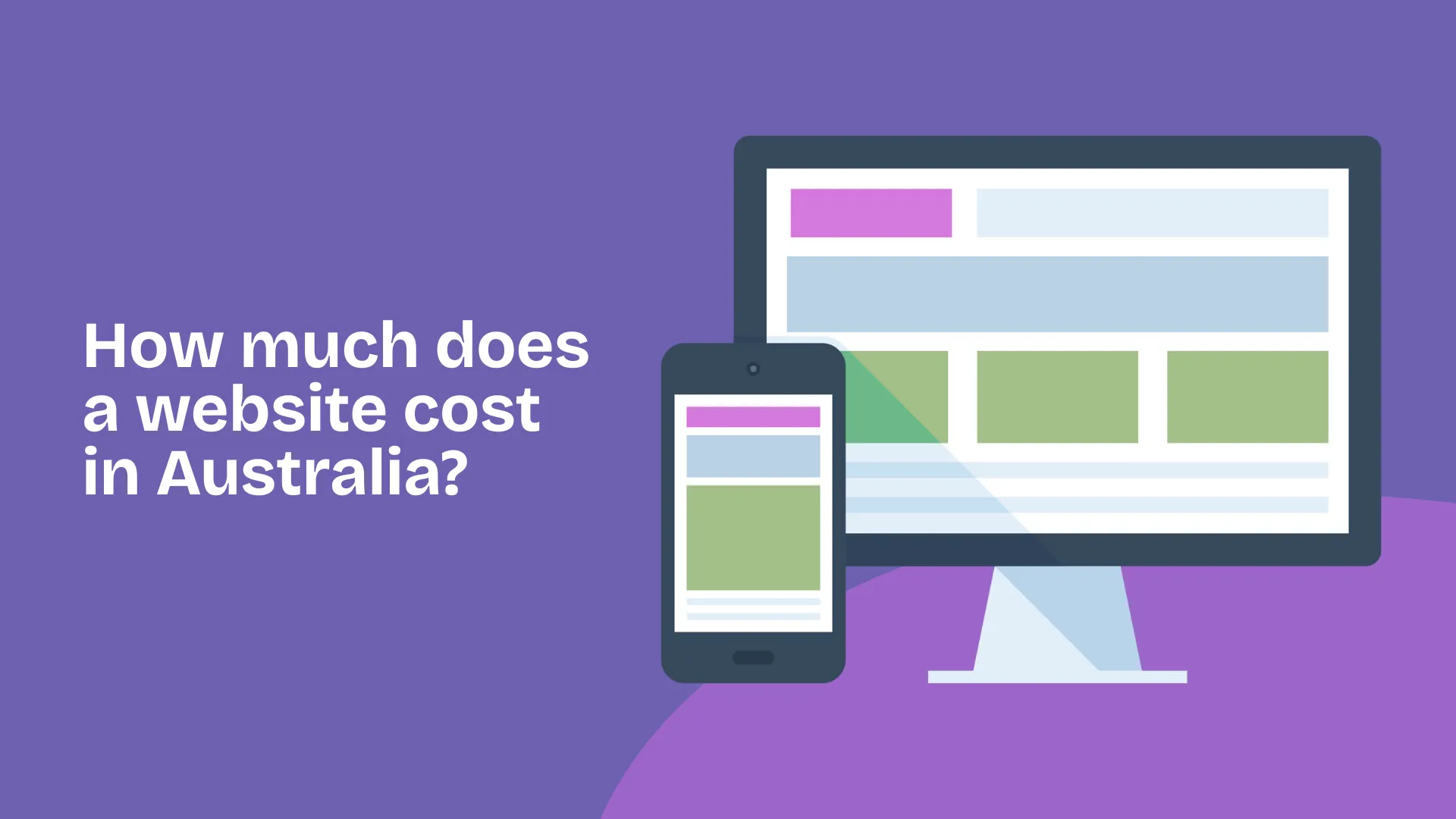How much should you really expect to pay for a website in Australia?
Most businesses begin with the same question when planning a website.
Cost is not just a number. It depends on what the website needs to include and how it will work for the business.
Planning the budget early helps define what the website will achieve, how it will function, and how it will grow with the business.
Whether the goal is to generate enquiries, sell products, or provide information, the cost reflects the design, content, features, and long-term maintenance required to meet that goal.
Costs can vary depending on the type of website, the depth of customisation, and how the design supports the business’s long-term goals.
What influences website costs?
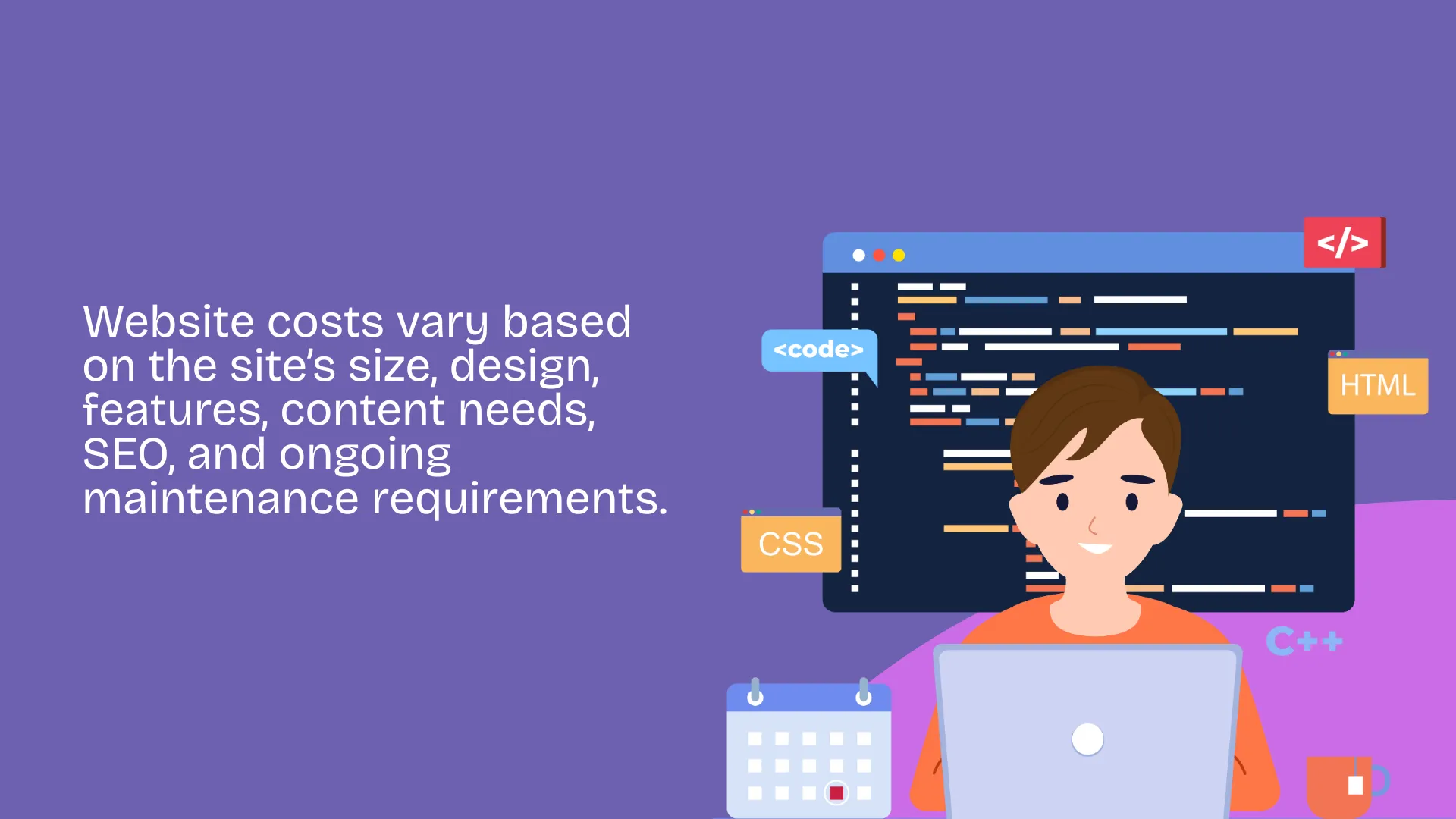
The cost of building a website can vary widely, and that often surprises business owners.
Two websites might look similar at first glance but cost completely different amounts to create. Why? Because no two websites work the same way.
Several factors come together to shape the final price.
Type and size of the website
A website with a few pages — like home, about, services, and contact — will naturally cost less than one with dozens of pages or specialised sections. If you need product catalogues, booking tools, or membership areas, the cost will increase as the structure becomes more complex.
Design complexity
Some websites use simple, familiar layouts. Others need custom designs that reflect a brand’s style, include interactive elements, or use advanced visuals. The more unique and detailed the design, the more time and skill required — and the higher the cost.
Features and functionality
Basic features include menus, contact forms, and image galleries. Adding eCommerce, online bookings, memberships, or custom integrations takes more development time. Each new feature adds value but also adds to the budget.
Content creation
Some businesses provide all their own content. Others need help writing copy, selecting images, or creating graphics and videos. Professional content can make a big difference in how effective a website is, but it also adds to the total cost.
SEO and technical optimisation
Every website needs some level of SEO. But if search engine visibility is a priority, more advanced optimisation will be necessary. This might include keyword research, technical tuning, image optimisation, and speed improvements — all of which require time and expertise.
Ongoing maintenance and updates
Websites are not a one-time project. Regular updates keep them secure, compatible, and running smoothly. More complex websites may also need technical support, adding to long-term costs.
Types of websites and how much they typically cost
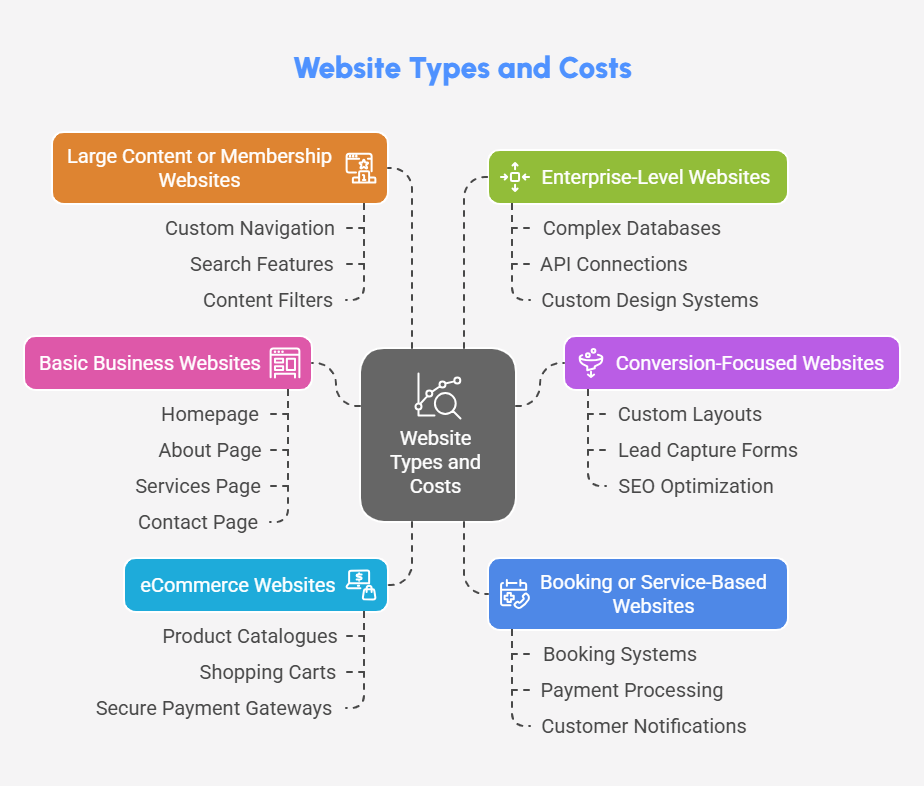
Website prices vary based on design, features, content, and business goals. Below are the most common website types and what businesses typically invest in each.
Basic business websites
These websites provide essential information about the business. Most include a homepage, about page, services page, and a contact page. Design is simple and focused on clear navigation. Suitable for small businesses that need a professional online presence without advanced features.
Typical cost: $2,000 to $5,000.
Conversion-focused business websites
These websites are designed to generate leads or enquiries. They include custom layouts, lead capture forms, stronger visual design, and SEO optimisation. Often used by service businesses aiming to increase customer enquiries or bookings.
Typical cost: $5,000 to $10,000.
eCommerce websites
Websites that sell products or services online. Key features include product catalogues, shopping carts, secure payment gateways, and shipping calculators. Costs increase based on the number of products, custom checkout options, and any advanced integrations.
Typical cost: $8,000 to $25,000+.
Booking or service-based websites
Websites that allow customers to book appointments or services directly online. Common features include booking systems, payment processing, and customer notifications. Costs vary depending on the complexity of the booking process and any custom scheduling features.
Typical cost: $6,000 to $20,000+.
Large content or membership websites
Websites with extensive content libraries or membership functionality. These may include custom navigation, search features, content filters, and secure user management. Used by businesses offering paid memberships, online courses, or gated content.
Typical cost: $10,000 to $40,000+.
Enterprise-level websites
Custom-built websites for larger businesses requiring advanced features, scalability, and integrations. Often include complex databases, API connections, custom design systems, and advanced security.
Typical cost: $25,000 to $75,000+.
What are the ongoing costs to run a website?
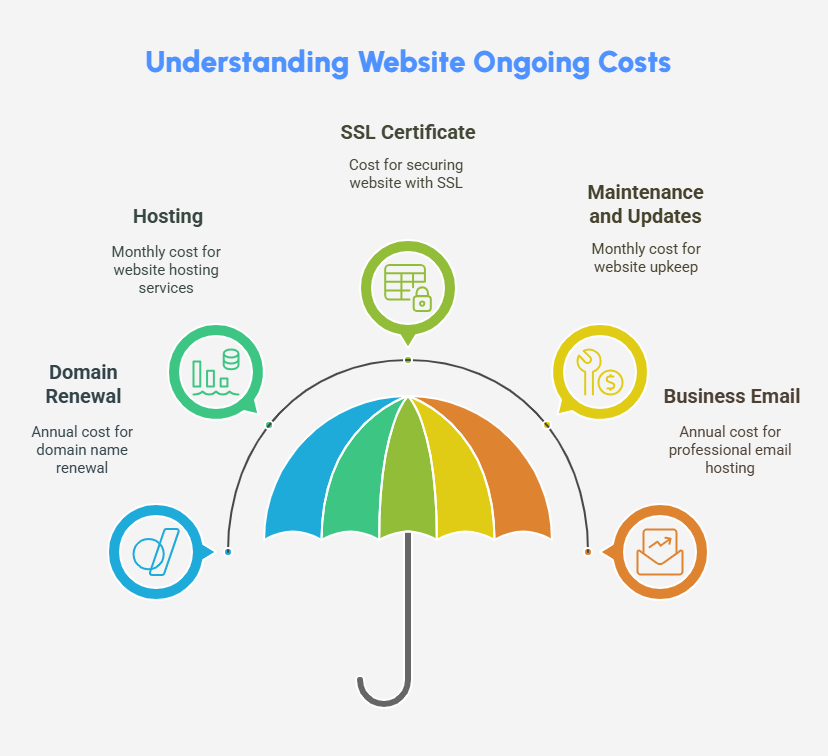
Once a website is live, several ongoing costs should be expected. These vary depending on the type of website, how much functionality is included, and how much maintenance the business requires.
Domain renewal
Most domain names renew annually. Pricing is usually low unless a business has premium domains or multiple variations.
Cost: $25 to $50 per year.
Hosting
Standard hosting costs range from basic shared hosting to managed services. The right option depends on the website’s size, expected traffic, and performance needs.
Cost: $40 to $100+ per month.
SSL certificate
Most websites now use free SSL certificates provided by Let’s Encrypt. Paid SSLs are rarely necessary unless extended validation or specific warranties are required.
Cost: $0 (Let’s Encrypt) or up to $150 per year for premium SSLs.
Maintenance and updates
Basic maintenance includes software updates, security monitoring, and minor content changes. More complex websites may need dedicated monthly support.
Cost: $50 to $300+ per month.
Business email
Some businesses pay for professional email hosting tied to their domain. Costs vary by provider and number of users.
Cost: $60 to $150 per user per year.
What is the typical process for building a website?
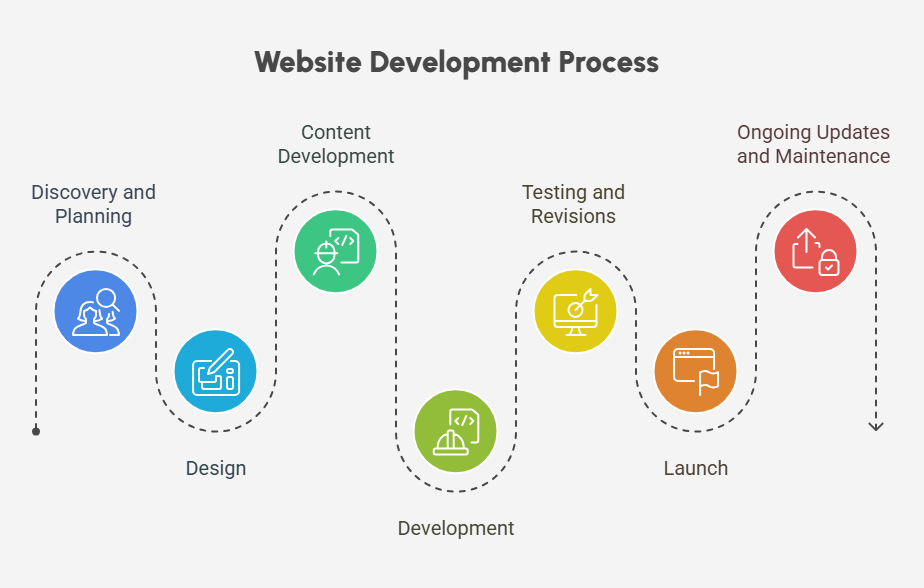
Understanding the process can help businesses plan their time and budget effectively. While every project is unique, most website builds follow these stages:
1. Discovery and planning
The project starts with gathering information about your business, goals, and target audience. This stage defines the structure, functionality, and key features your website needs.
2. Design
The design phase includes creating layouts, selecting colour schemes, and planning how visitors will navigate the site. Custom designs often involve reviewing mockups and providing feedback before development begins.
3. Content development
Content is prepared for each page. Some businesses provide their own text and images, while others choose professional copywriting, photography, or graphic design services.
4. Development
The approved design is turned into a working website. This includes coding, adding functionality, integrating third-party tools, and making the site responsive across different devices.
5. Testing and revisions
Before launch, the website is tested to ensure everything functions correctly. This includes checking speed, mobile compatibility, forms, and security features. Revisions are made based on testing results.
6. Launch
Once approved, the website goes live. Domain settings are updated, and the site is made available to the public.
7. Ongoing updates and maintenance
After launch, regular updates, maintenance, and content additions keep the website secure, functional, and aligned with business goals.
Popular platforms and CMS options
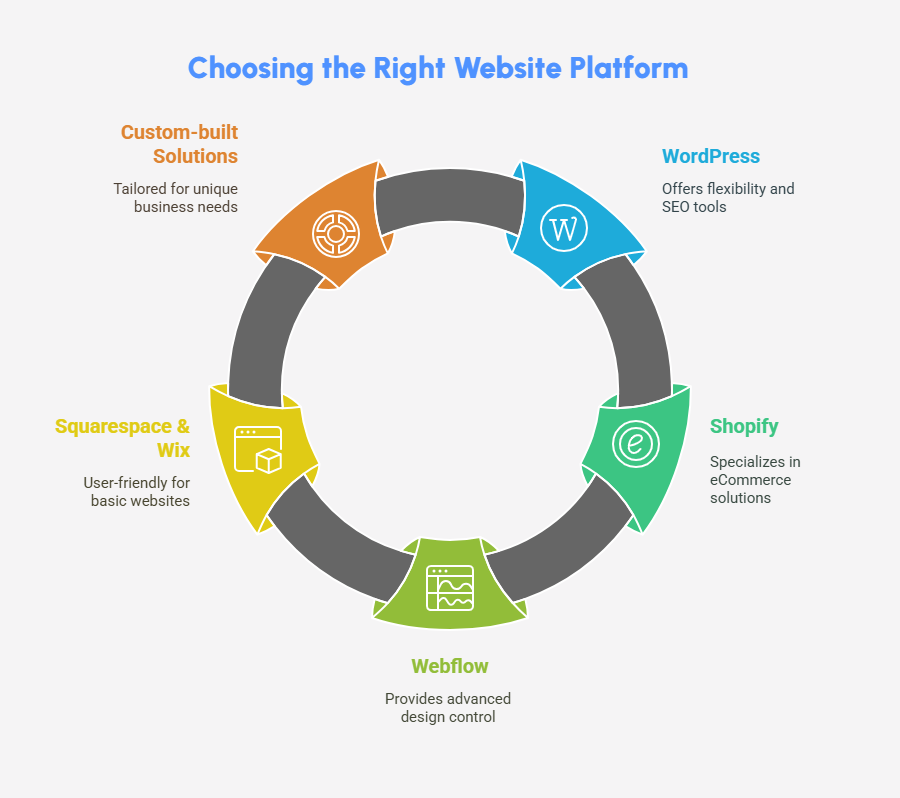
Choosing the right platform or content management system (CMS) is a critical step in any website project. The platform affects flexibility, ease of use, maintenance, and scalability.
Here are the most common options:
The world’s most widely used CMS. WordPress offers flexibility, strong SEO tools, and access to thousands of themes and plugins. Suitable for almost any website type. Ongoing maintenance is required to keep the site secure and fast.
Best for: Businesses needing flexibility and scalability.
A leading eCommerce platform with built-in tools for managing products, payments, and shipping. Easy to manage without advanced technical skills. Design flexibility is more limited compared to fully custom sites.
Best for: Businesses selling products online.
A popular choice for businesses that want advanced design control without relying on developers. Webflow offers a visual builder, built-in hosting, and requires less maintenance than WordPress. Highly customisable without extensive coding.
Best for: Businesses needing custom design flexibility and easier content management.
Squarespace and Wix
User-friendly website builders offering simple drag-and-drop tools. Best for businesses needing a basic online presence with minimal complexity. Limited design flexibility and scalability for larger projects.
Best for: Small businesses with basic website needs and smaller budgets.
Custom-built solutions
For businesses with unique needs, custom-built websites provide complete control over design and features. These projects often require larger budgets and longer development timelines but allow for advanced functionality.
Best for: Large businesses or organisations requiring specialised features and scalability.
How much does it cost to build a custom WordPress website?
The price of a custom WordPress website depends on the design, features, and the level of development required. Costs vary based on whether the website is a simple online presence or a fully customised platform with advanced functionality.
Basic custom WordPress website
Most small businesses pay between $3,000 and $6,000. This usually covers standard pages like home, about, services, and contact, plus custom design using a premium or starter theme, mobile responsiveness, and basic SEO setup.
Conversion-focused WordPress website
Websites designed to attract leads and enquiries typically cost between $6,000 and $12,000. These include custom layouts, lead capture forms, and SEO optimisation to support marketing and conversion goals.
WordPress eCommerce website (WooCommerce)
Adding eCommerce features increases the cost. Websites with product catalogues, shopping carts, payment gateways, and shipping tools usually range from $8,000 to $20,000 depending on the number of products and complexity.
Advanced custom WordPress website
Websites requiring unique designs, custom post types, third-party integrations, or specialised features often start at $12,000 and can exceed $40,000.
Additional cost factors
Custom plugin development, third-party software integration, content creation, or advanced SEO and performance optimisation can raise the price further. Planning the full scope early helps avoid unexpected costs.
Related: What’s the Difference Between a Website and a Funnel?
How much does it cost to build an eCommerce website?
The cost of an eCommerce website depends on the size of the store, the number of products, and the complexity of features required. Pricing also varies based on design expectations and any custom integrations needed for payments, shipping, or customer management.
Basic eCommerce website
Smaller online stores with a simple product catalogue, shopping cart, secure payment gateway, and standard shipping options usually range from $8,000 to $15,000. These projects use ready-made platforms with moderate design customisation.
Conversion-focused eCommerce website
Websites designed to increase sales and customer engagement typically cost between $15,000 and $25,000. They include custom design, optimised checkout, advanced shipping rules, and sales reporting features.
Advanced eCommerce website
Stores with large product ranges, product variations, complex payment setups, multi-location shipping, or third-party software integrations often start around $20,000 and can exceed $40,000.
Additional cost factors
Costs can increase if the website requires custom development, advanced filtering options, wholesale pricing, CRM integration, or multilingual support. Ongoing fees for payment processing, shipping services, and platform subscriptions should also be considered.
Final thoughts
Website costs vary because no two businesses have the same goals, design requirements, or functionality needs. Whether it’s a simple information site or a complex eCommerce platform, the right investment depends on the features that will support growth and provide long-term value.
Planning ahead, understanding the different cost factors, and working with professionals who align with your goals can help avoid unnecessary expenses and delays.
A well-built website is not just a cost — it’s an asset that supports marketing, sales, and customer engagement. Investing wisely from the start ensures your website delivers results and scales with your business over time.
